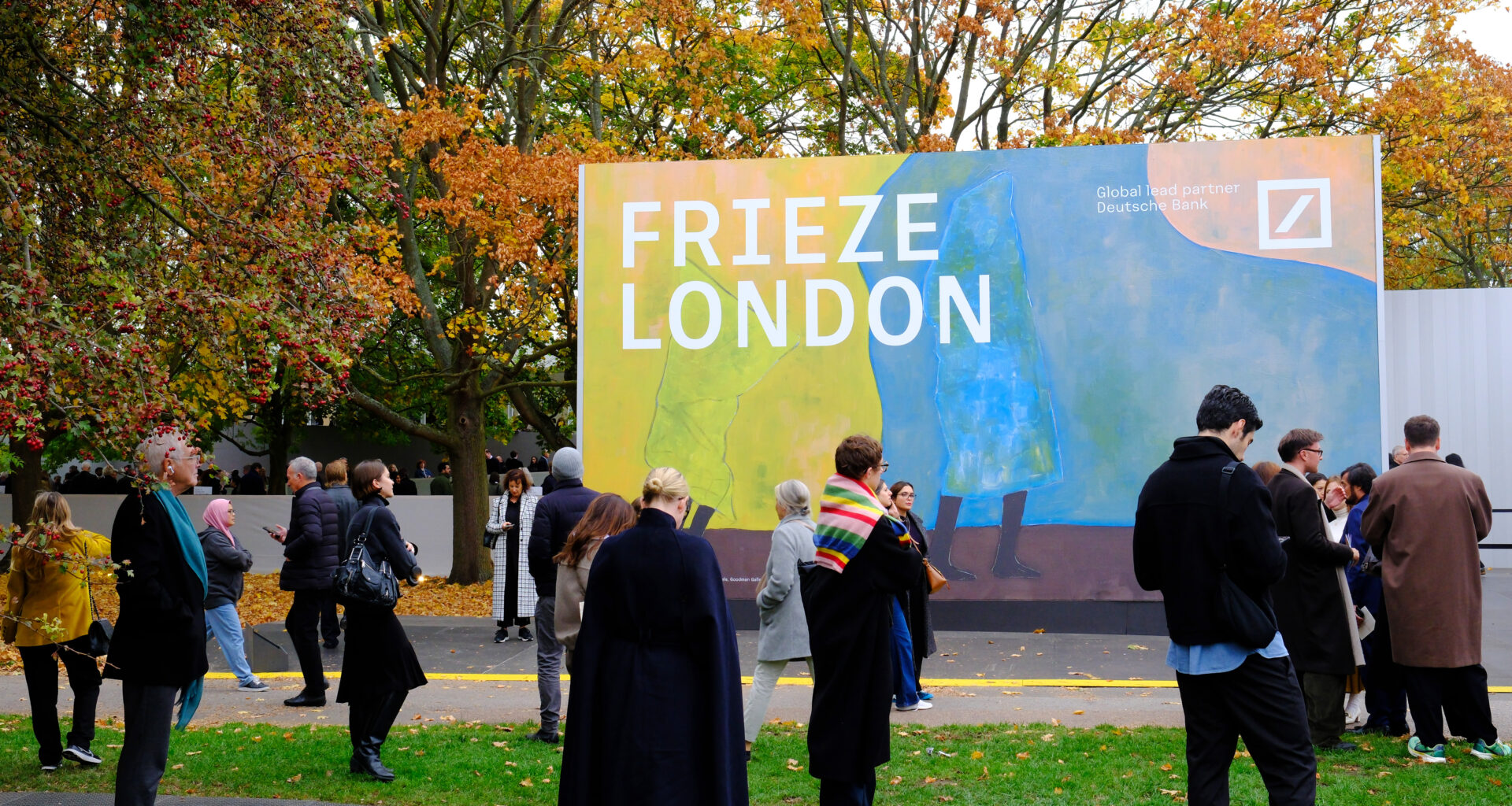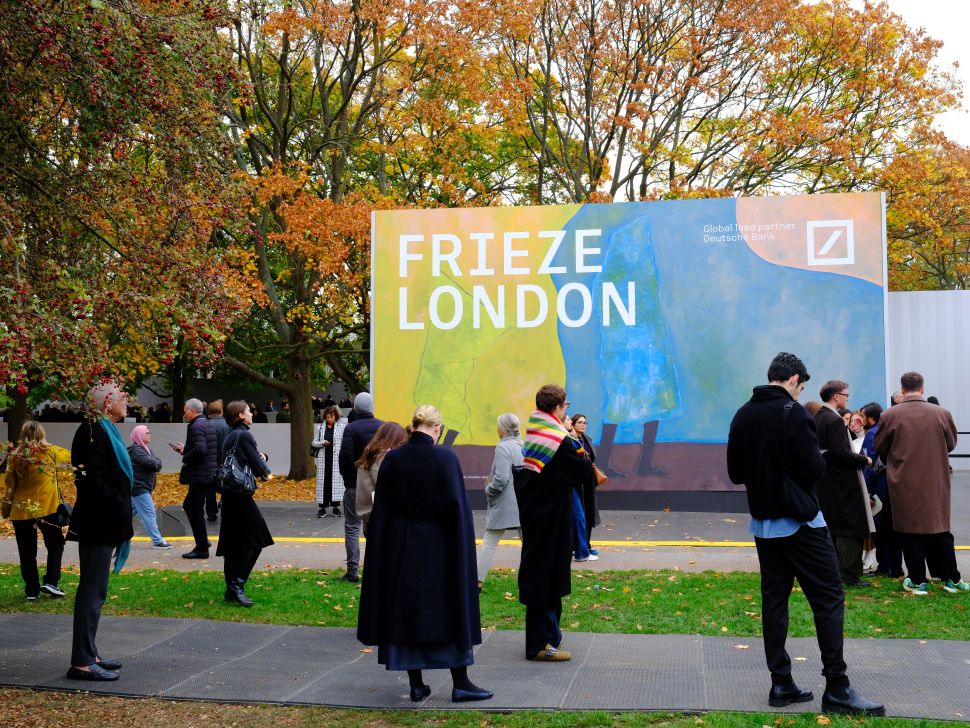 Frieze London and Frieze Masters opened on October 15. Photo: Linda Nylind | Courtesy of Frieze
Frieze London and Frieze Masters opened on October 15. Photo: Linda Nylind | Courtesy of Frieze
The energy on the opening day of Frieze London on October 15 felt less like a post-Brexit correction and more like the city sliding back into its golden age. Christie’s confirmed it later that evening with a £106,925,400 record result—the highest total for a Frieze Week Evening Sale in seven years. Despite fewer collectors from the U.S. and Asia, London became a playground for British and European collectors, with Italians as present as the French, Eastern Europeans and even Africans, resulting in a healthy stream of sales across every tier of the market.
VIPs entered at 11 a.m.; by noon, the aisles were already dense with kiss-and-check choreography and buyers eager to transact before lunch and champagne. It felt as though London had simply been waiting to bring the party back to town, and everyone showed up in their best outfits, best smiles and best manners—staging a flawless spectacle of British and European opulence. Galleries across the main and curated sections brought unusually high-quality works: heavy blue-chip statements, sharp experimentation and, at Frieze Masters, art-historical gems.
Among the advisors most visibly active on the ground was Philip Hoffmann of New Perspective Art Partners and Fine Art Group, who confirmed that the atmosphere at both Frieze and Frieze Masters was exceptionally vibrant. “Many dealers said they exceeded their expectations. Several Old Master dealers mentioned they had a very strong day—three or four times better than last year. Most of the big galleries sold out their young contemporary presentations, either fully pre-sold or gone on the first day,” he noted when we spoke in the evening. “Overall, I’d say sentiment in London was far above expectations.” While Hoffmann acknowledged that the market may not yet be back to the peak of five years ago, he emphasized that it already feels “significantly stronger than at the beginning of this year.”
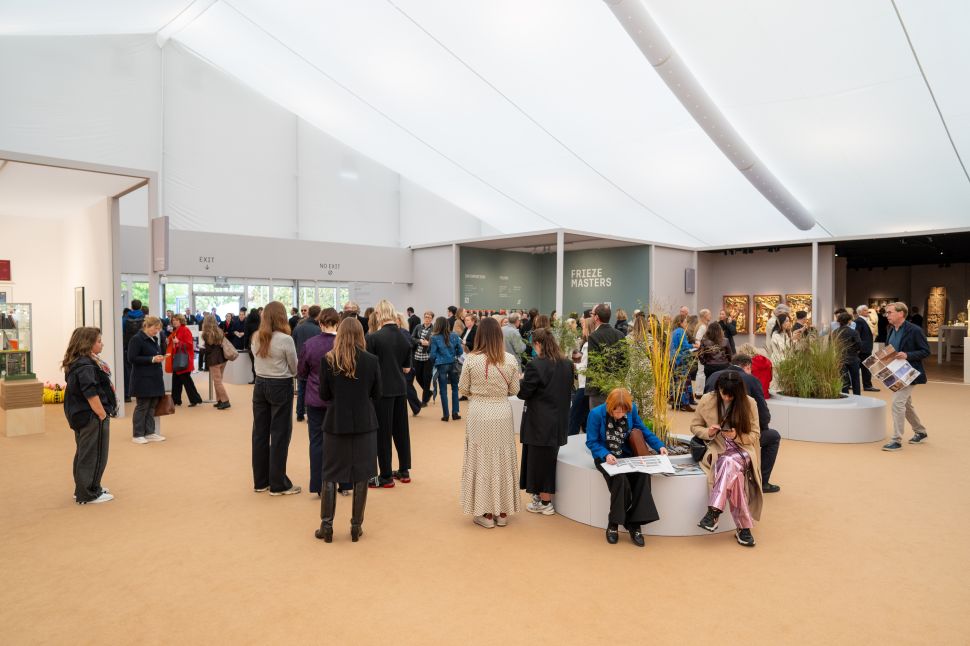 Opening day at Frieze Masters 2025. Photo by Hugo Glendinning, courtesy of Frieze
Opening day at Frieze Masters 2025. Photo by Hugo Glendinning, courtesy of Frieze
The mood at Regent’s Park was so buoyant that even Gagosian—typically allergic to reporting numbers—happily announced a complete sell-out by noon of its Lauren Halsey solo presentation: collage murals and sculptural reliefs merging South Central L.A.’s visual memory with ancient Egyptian and Mesoamerican cosmologies, elevating community narrative and creativity into a monument of historical record and a celebration of Black American culture.
Nearby, Zwirner’s booth was anchored by a large, atmospherically abstract photograph by Wolfgang Tillmans, with two works by the Swiss photographer selling for prices between $115,000 and $250,000. Additional highlights included a painting by Steven Shearer for $550,000, two paintings by Lucas Arruda in the $320,000-$350,000 range, a work on paper by Elizabeth Peyton for $300,000 and another by Lisa Yuskavage for $180,000. Two significant works on paper by Kerry James Marshall sold for $65,000 each on the first day, coinciding with a major survey at the Royal Academy of Arts in London. The gallery also placed a painting by Victor Man, who opened his latest show there this week. Further sales included two works by Christopher Williams in the $45,000-$50,000 range, two works on paper by Huma Bhabha for $45,000 each, a painting by Sosa Joseph for $35,000 and four paintings by Frank Walter at $18,000 each.
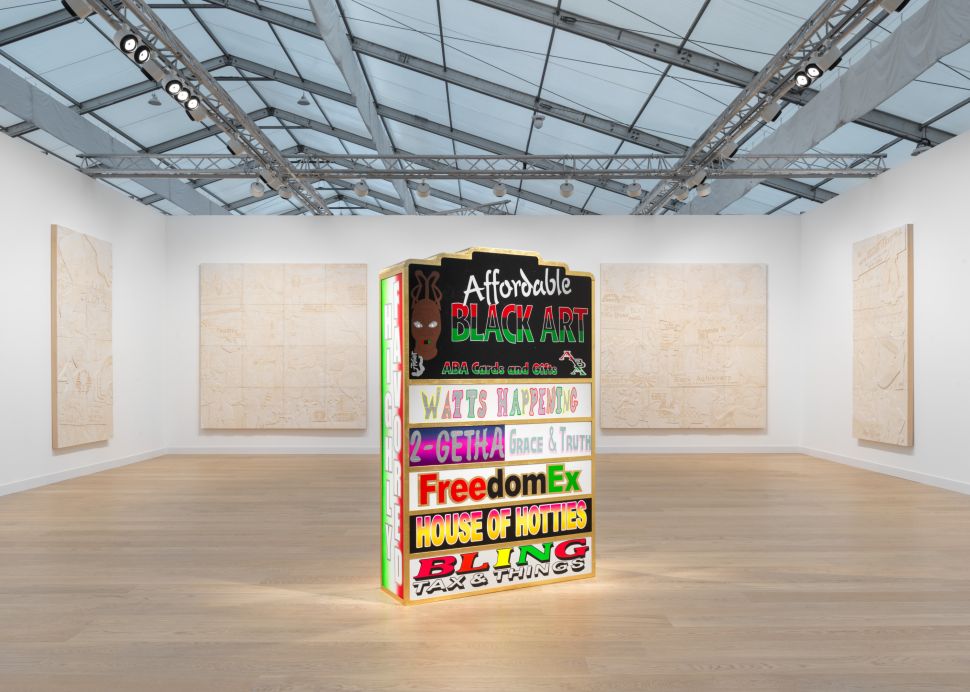 Gagosian at Frieze London 2025. © Lauren Halsey | Photo: Maris Hutchinson, courtesy Gagosian
Gagosian at Frieze London 2025. © Lauren Halsey | Photo: Maris Hutchinson, courtesy Gagosian
Taking over an entire wall of Hauser & Wirth’s booth was a large new painting by George Rouy, placed immediately for $275,000. It was joined by other in-demand names from the gallery’s roster: a new painting by Avery Singer (inspired by Boccioni) sold for $800,000, and an Ellen Gallagher painting sold for $950,000 as one of the top sales of the day. The gallery also placed a George Condo painting for $200,000, works by Keith Tyson and Henry Taylor at $300,000 each, Angel Otero at $285,000, Lee Bul at $260,000 (following her major show at Leeum Museum), a Takesada Matsutani painting for $250,000, Anj Smith at $170,000, Lorna Simpson at $150,000 (following her Met show), Allison Katz at $45,000 (benefiting the Gallery Climate Coalition), Jenny Holzer at $40,000 and two Christina Kimeze works at £40,000 each.
Meanwhile, at Frieze Masters, the Swiss mega-gallery gave Nicolas Party carte blanche to construct a booth of historical gems—and every significant piece sold on the first day: Gabriele Münter for CHF 2,400,000, René Magritte for $1,600,000, Paul Klee for €1,450,000, Marcel Duchamp for $1,350,000 and an uncannily sensual Alina Szapocznikow sculpture for $1,200,000. Further placements included Jack Whitten at $750,000, Man Ray at €380,000, Francis Picabia at €325,000 and Meret Oppenheim at CHF 225,000, along with works by Louise Bourgeois, Alberto Giacometti, Sonia Delaunay, Hans Arp and Hans Emmenegger. As Iwan Wirth noted, these sales prove that true connoisseurs remain independent thinkers—impervious to trends and noise.
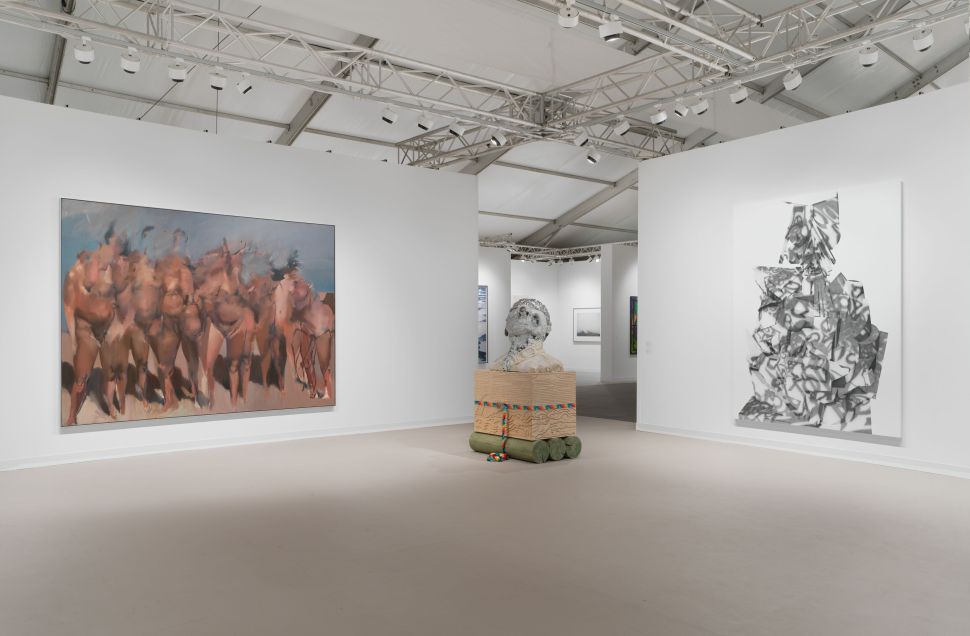 Hauser & Wirth at Frieze London 2025. Courtesy the artists / estates and Hauser & Wirth. Photo: Alex Delfanne
Hauser & Wirth at Frieze London 2025. Courtesy the artists / estates and Hauser & Wirth. Photo: Alex Delfanne
Thaddaeus Ropac also had a blockbuster day: a Robert Rauschenberg mixed-media work at $850,000, two Antony Gormley sculptures at £500,000 each, a Daniel Richter painting at €420,000, a Tony Cragg wooden sculpture at €360,000, an Erwin Wurm aluminum work at Frieze Sculpture for €330,000, a Gilbert & George 15-panel work for $225,000, a Liza Lou for $225,000, a Joan Snyder for $175,000, two Megan Rooney paintings at £90,000 each, a ZADIE XA painting at £90,000, an Oliver Beer pigment on canvas for £55,000, a Hans Josephsohn brass work at CHF 60,000, an Antony Gormley ink on paper at £50,000 and a Joan Snyder work for $15,000, with 10 percent donated to the Gallery Climate Coalition.
Wrapping an entire wall of Lisson’s booth was a monumental tapestry by Otobong Nkanga—an extension of the interspecies symbiosis and ecological storytelling she recently presented at MoMA. Although the gallery also brought more ambitious, institution-level works, it reported solid early sales on the first day, including a sculpture by Ryan Gander for £85,000 and two works by Sarah Cunningham for $26,000.
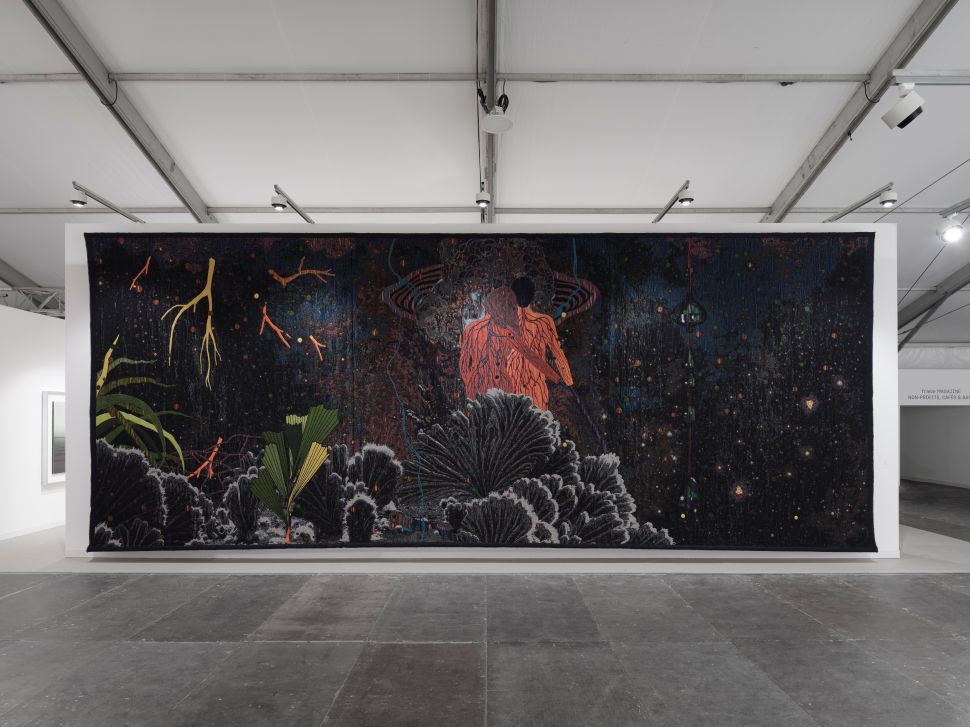 Lisson at Frieze London 2025. Courtesy Lisson Gallery
Lisson at Frieze London 2025. Courtesy Lisson Gallery
Museum-profile artists were also in high demand at Lehmann Maupin, which placed over fifteen works by Korean artist Do Ho Suh in conjunction with his major solo survey, “Do Ho Suh: Walk the House,” currently on view at Tate Modern through October 26. “This year marks our 21st time participating in Frieze London and our 6th year operating a gallery space in the city, and over the years, we’ve been able to see the art market’s consistency and resiliency here up close. Overall, this week has really felt like a celebration of the success of our London-based artists, including Do Ho Suh,” Isabella Icoz, partner at Lehmann Maupin, said, noting that other artists in their roster also have a strong presence in the city. Gilbert & George just opened their solo exhibition “21st Century Pictures” at the Hayward Gallery, and Teresa Solar Abboud, who recently joined the gallery, debuted a new site-specific commission there as well.
Clearly targeting museums and curators was the two-person booth of Peter Blum, presenting significant works by institutionally acclaimed artist Nicholas Galanin alongside paintings by Rebecca Ward. The gallery sold five of Ward’s works for a total of $125,000 to private collections in the U.S. and the U.K.
 Peter Blum at Frieze London 2025. Photo: MICHAEL ADAIR
Peter Blum at Frieze London 2025. Photo: MICHAEL ADAIR
A clear trend at Frieze this year was the prominence of spiritually attuned works proposing more harmonious, cosmological relationships with nature. White Cube captured this energy most powerfully, pairing Marguerite Humeau, Howardena Pindell and Sara Flores—three artists exploring the human–natural world connection through material, ritual and energy. Collectors responded immediately, resulting in multiple sales: Humeau’s large-scale bronze sold for £200,000, additional bronze sculptures sold for £65,000 and £50,000 and three works on paper placed at £65,000, £65,000 and £40,000. Pindell’s mixed-media painting sold for $150,000, while large paintings by Flores were placed at $115,000 and $70,000.
Pace devoted its entire booth to William Monk, whose luminous kaleidoscopic portals into light and nature drew collectors into polite territorial negotiations depending on size, budget and proximity. Seven paintings sold within hours, priced from $30,000 to $295,000, going to prominent private collectors across Asia and Europe. At Frieze Masters, the gallery shifted registers with a full booth of Peter Hujar’s backstage portraits of 1970s and 1980s New York, placing six works with European and American collectors ahead of his upcoming 2026 show at the Morgan Library in New York.
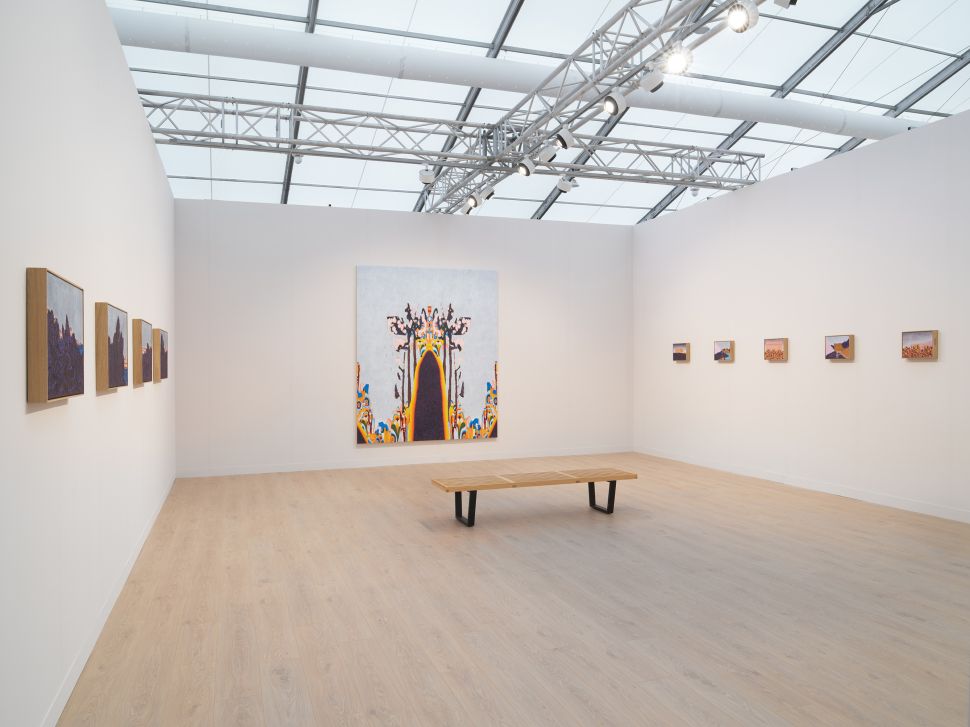 Pace Gallery presenting William Monk at Frieze London 2025. Robert Glowacki Photography
Pace Gallery presenting William Monk at Frieze London 2025. Robert Glowacki Photography
Sean Kelly echoed a similar tone, presenting a three-person booth featuring Julian Charrière, Sam Moyer and Laurent Grasso. “We’ve had an excellent first day,” partner Cécile Panzieri told Observer. “We’ve placed multiple works by Moyer, a major painting by Grasso, an important sculpture by Charrière, and several more conversations are ongoing.”
Not far from his father-in-law—and now confidently entering the mega-gallery lane—Matthew Brown delivered a flurry of early sales: a four-part pencil work by Kenturah Davis for $80,000; a Carroll Dunham painting for $60,000 plus two drawings at $6,000-$17,500; a Mimi Lauter work for $60,000; three Julie Beaufils paintings (prices undisclosed); two Uri Aran works at $22,000-$28,000; two Kent O’Connor paintings at $8,000-$12,000; two Michelle Uckotter works at $9,500-$12,000; an Omari Douglin painting for $10,000; and an Olivia van Kuiken painting for $4,500.
Also maintaining its blue-chip side, the former Kasmin—now Olney Gleason—sold a Robert Indiana for $200,000, a Diana Al-Hadid for $90,000, three Sara Anstis works between $10,000 and $50,000, two Cynthia Daignault pieces, two Alexis Ralaivao paintings, a work by vanessa german and one by Lyn Liu.
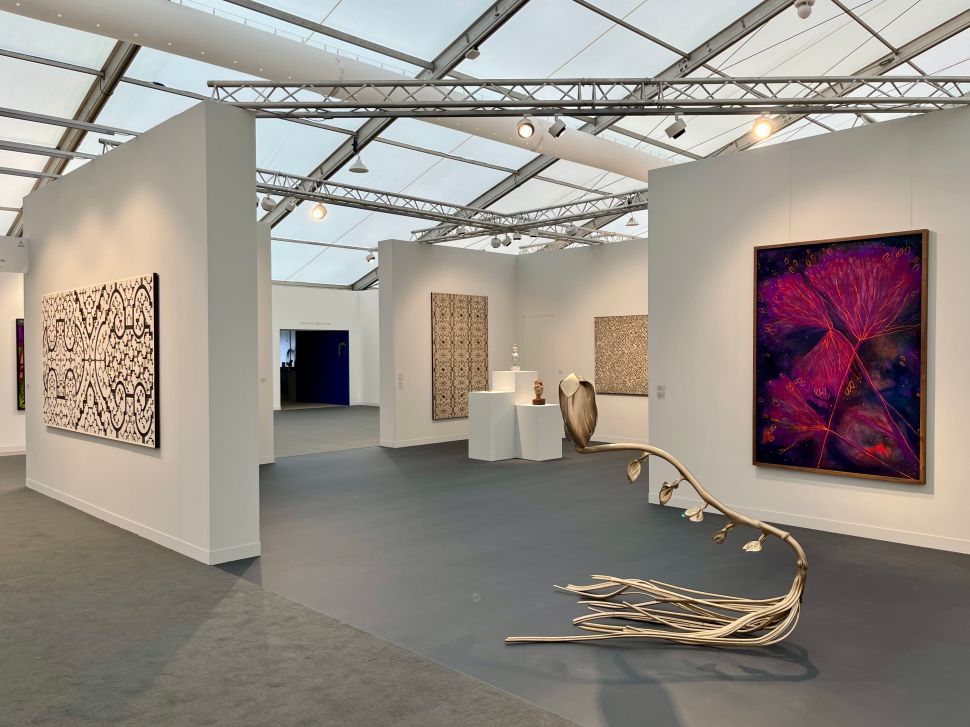 White Cube at Frieze London 2025. Photo Alex Burdiak (White Cube)
White Cube at Frieze London 2025. Photo Alex Burdiak (White Cube)
Meanwhile, on the contemporary side, London-based dealer Timothy Taylor saw success, nearly selling out his entire booth dedicated to London-based artist Daniel Crews-Chubb, with prices ranging from £70,000 to £95,000. GRIMM also reported a strong opening day, placing 15 works with several more on hold. Highlights included a significant painting by Louise Giovanelli placed with a U.K. museum for £80,000, a Gabriella Boyd work at £33,000 and multiple sales by the gallery’s newest addition, Anna Ruth, who had four works placed in the €5,000-14,000 range ahead of her first solo show with the gallery in Amsterdam in April 2026. Additional sales included a Daniel Richter for €120,000, a Tommy Harrison for £25,000, an Angela Heisch for $45,000, a Jonathan Wateridge for £7,000, a Ciarán Murphy for €9,000, a Rafał Topolewski for €12,000 (acquired by a London-based public collection) and a Fischer Mustin for £3,850. Further placements included an Anders Davidsen for €13,000, two Liza Jo Eilers works at $6,000 each and another Tommy Harrison for £25,000.
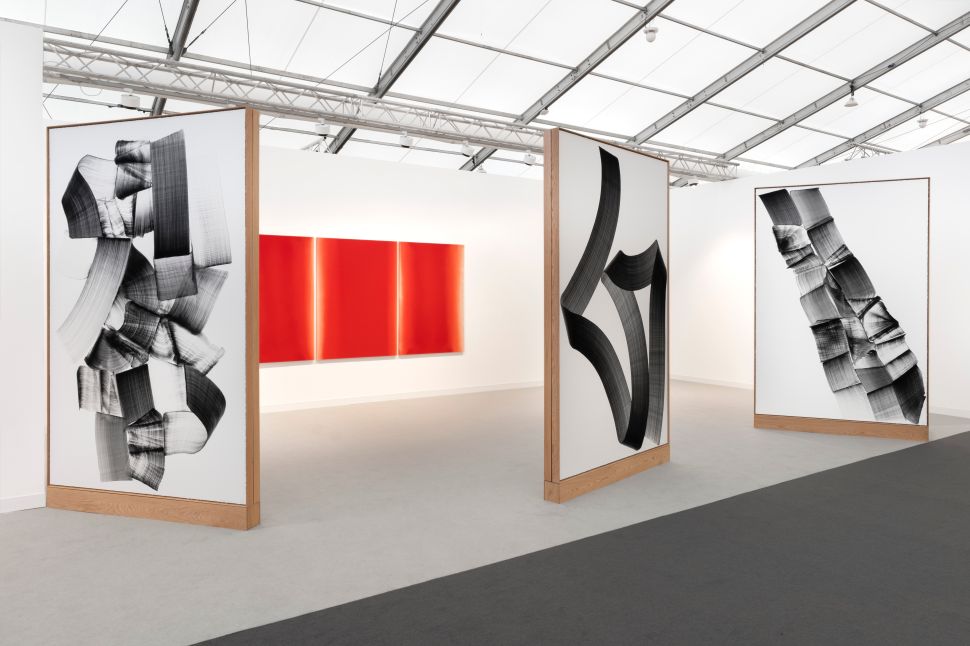 Johyun Gallery at Frieze London 2025. Courtesy Johyun Gallery
Johyun Gallery at Frieze London 2025. Courtesy Johyun Gallery
Demand for Korean art remains strong. Tina Kim Gallery reported a robust opening day, placing a Ha Chong-Hyun painting for $550,000, two paintings by Kibong Rhee for $100,000 and $80,000, a textile work by Lee ShinJa for $70,000, a multimedia work by Pacita Abad for $35,000 and a Maia Ruth Lee painting for $24,000. Meanwhile, her mother’s gallery, Kukje, also sold across the board: two Ha Chong-Hyun paintings ranging from $230,000 to $313,600, a Kibong Rhee between $90,000 and $108,000, a Kim Yun Shin work for $20,000-24,000, a Park Chan-kyong painting for $2,500-3,000 and a Heejoon Lee for $5,000-6,000. At Frieze London, Johyun Gallery paired Lee Bae with the luminous abstractions of Kim Taek Sang, while at Frieze Masters, it presented a full black booth of later Park Seo-Bo paintings alongside a 1960s example—drawing strong interest and sales at both ends of the market.
Space for discoveries and experimentation
Frieze London remains especially worth the visit for its global range at every level—and this year, the best discoveries once again greeted visitors near the entrance, when energy and attention were still high before navigating the full sweep of 280 exhibitors across Frieze London and Frieze Masters.
Near the entrance, ATHR Gallery from Saudi Arabia presented a two-artist booth featuring Daniah Alsaleh and Basmah Felemban, both exploring the Kingdom’s natural and cultural landscapes as sites in flux—continuously reshaped by the movement of people, ecologies and stories. The presentation attracted international collectors, with five works by Daniah Alsaleh placed, including one for £5,500, two for £4,700 each and three at £2,400 apiece, along with a work by Felemban for £2,515 and a photographic print by Mohammad Alfaraj for £1,900.
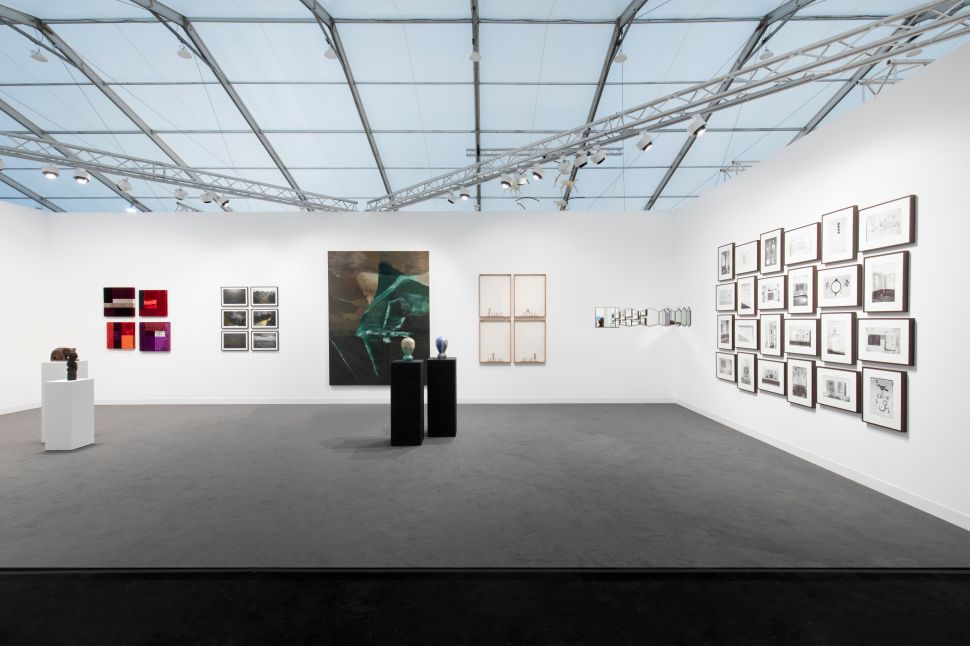 Vadehra Art Gallery at Frieze London 2025. Photo by Gabriele Abbruzzese.Courtesy of Vadehra Art Gallery.
Vadehra Art Gallery at Frieze London 2025. Photo by Gabriele Abbruzzese.Courtesy of Vadehra Art Gallery.
Several galleries from India made a notable impact at Frieze this year, underscoring the country’s accelerating role in the global art market. Leading the charge, Vadehra Art Gallery reported multiple sales ranging from $7,500 to $40,000 across both established and emerging names from India and its global diaspora. Among the highlights, a work by Ashfika Rahman was placed with an institution for $27,000, alongside works by Anju Dodiya—signaling continued confidence in the depth and diversity of South Asian art. The gallery also placed works by Leela Mukherjee, Astha Butail, Shilpa Gupta, Biraaj Dodiya and Faiza Butt with a mix of private and public international collections. As part of their solo presentation, “Ancestral Log” in the Studio section—reimagining the studio as an interior theatre of the psyche, where memory, myth and selfhood collide—Vadehra sold three large works by Anju Dodiya for £37,000 each. Meanwhile, Mumbai- and Kolkata-based Experimenter sold works by every artist in their presentation, further confirming the momentum of the Indian scene.
This year, the Focus section featured some of the most interesting discoveries and experimental presentations with a global breadth. Beirut-based Marfa delivered one of the most quietly arresting booths, with a solo by Omar Fakhoury, whose intuitive, painterly visions were hauntingly introspective and psychologically dense. Fresh off the momentum of Liste, his works also stood out for their accessibility, priced between $2,000 and $7,000.
Cairo-based Gypsum also received a strong response for its two-person booth spotlighting two rising young Egyptian female artists. Through fractured sculptural ceramic reliefs and hand-stitched tapestries, both artists explore intertwined themes of labor and leisure by examining the industrial and socio-political heritage of the port city of Alexandria—and the nationalist representations it produced. On the first day, the gallery placed both of Marianne Fahmy’s hand-stitched tapestries with London- and Turkish-based collections at €15,000 each.
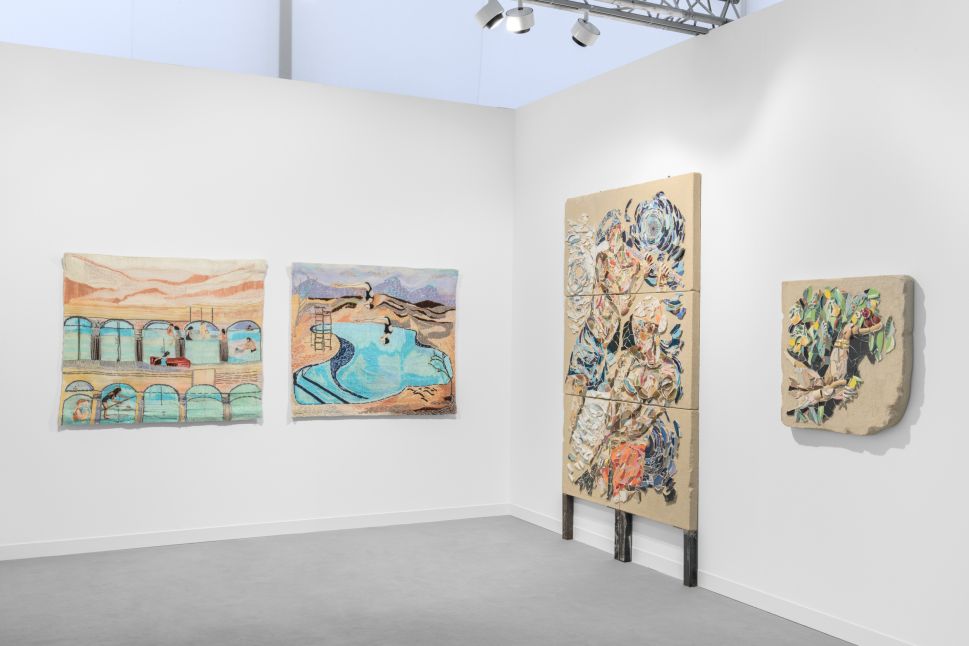 Gypsum at Frieze London 2025. Julian Blum
Gypsum at Frieze London 2025. Julian Blum
Sold out by the evening was El Apartamento’s two-person presentation of Cuban artists Ariamna Contino and Alex Hernández, featuring mixed-media works priced between $6,000 and $55,000—all placed with European private collectors. Contino and Hernández’s work translates scientific principles and statistics into art to examine urgent issues shaping contemporary society, from environmental health and social equilibrium to human mobility and the complexities of human behavior.
Nearby, in its fourth appearance at Frieze, Shanghai-based Vacancy debuted the nuanced, dreamlike paintings of young Chinese talent Xingzi Gu—poetic meditations on the porous boundary between sensory experience and its emotional or psychological afterimage. Working in diluted washes of pastel and jewel-toned acrylics, her atmospheric canvases unfolded like visual emotional murmurs and subtle fading memories.
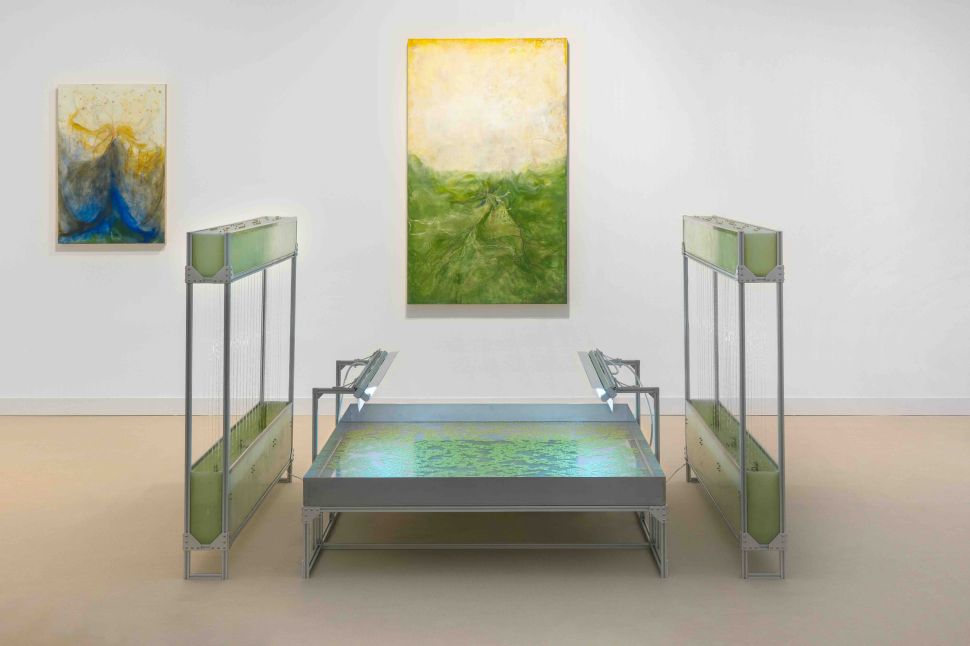 Public Gallery at Frieze London 2025. Courtesy Public Gallery
Public Gallery at Frieze London 2025. Courtesy Public Gallery
One of the most compelling booths in the section came from Public Gallery, presenting a solo by London-based Xin Liu, who continues her investigation into exchanges between human and non-human realms through a distinctive blend of cutting-edge technology, scientific rigor and futuristic imagination. Centered on her concept of “cosmic metabolism”—which draws parallels between human behavior and microbiotic systems—Liu transformed the booth into a lab-like ecosystem: a rectangular steel tank cultivating fast-replicating duckweed, an invasive species often blamed for choking ponds yet now studied as a potential food and fuel source for outer space, flanked by two towers dripping continuous streams of viscous liquid. This living installation stages the tension between overproduction and renewal, using duckweed as a metaphor for fertility under social and technological pressure. Her accompanying encaustic works, made of beeswax, resin and embedded silk threads, evoke root systems, capillaries and genetic maps, extending the same inquiry into a material and sensual form. Inspired by Han Kang’s The Vegetarian and filtered through a techno-feminist lens, Liu links botanical transformation to female identity, prompting a timely reflection on how the body is biologically and culturally constrained—while questioning how the very notions of identity, ecology and social structures may need to be radically reconfigured to endure in fast-changing ecosystems.
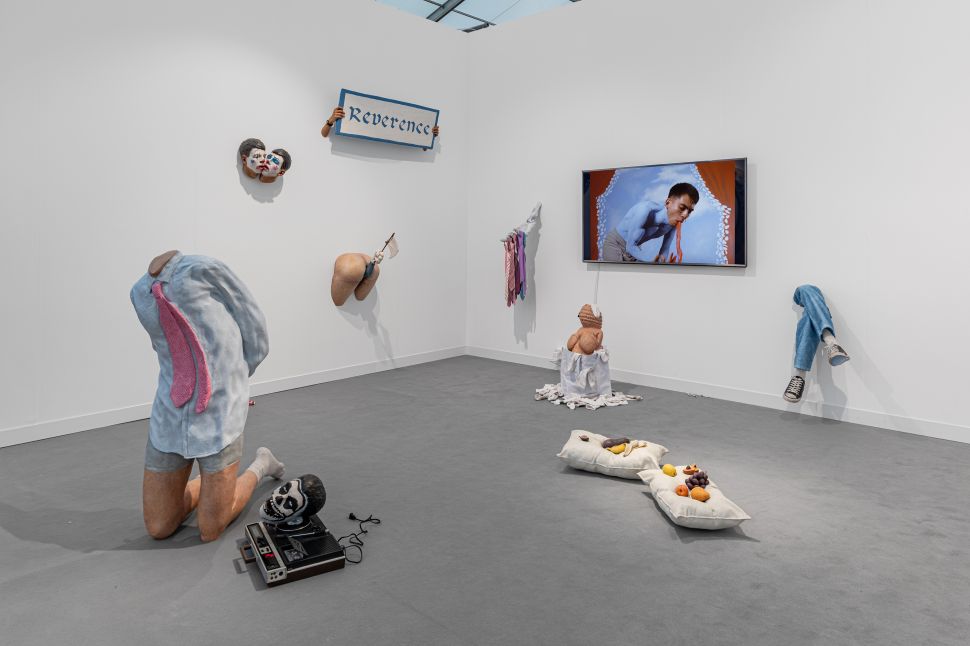 LLANO at Frieze London 2025. Courtesy LLANO
LLANO at Frieze London 2025. Courtesy LLANO
The Focus section also made space for video installations and digital art, including a fascinating video by Korean London-based artist Enju Lee, presented by Niru Ratnam, which explored interspecies relationships through poetic and visionary digital imagination. Nearby, Mexico City-based LLANO made a strong Frieze debut with a multimedia work by Enrique López Llamas that, combining parody, humor and sociological critique, examines repetition and failure as the core mechanics of both adulthood and art-making—a Sisyphean cycle of trial and error, risk and reward, shame and assurance, swinging between impostor syndrome and full main-character energy.
Similarly immersive and experimental was Gathering’s solo booth by Christelle Oyiri, who conceived a complete multimedia environment fusing playful acid-green visuals with a club-like aesthetic. Beneath its seductive surface, the work delivered a sharp critique of the long-term effects of chlordecone contamination in Martinique and Guadeloupe—a toxic pesticide scandal still impacting local bodies and land—while drawing a pointed parallel to a new form of colonial extraction: the tourist economy’s ongoing exploitation of the same islands. The presentation follows her recent commission at Tate earlier this year.
Other standout presentations appeared in “Echoes of the Present,” a new themed section at the center of the fair curated by Jareh Das, exploring an intergenerational dialogue between contemporary artists from Brazil, Africa and their diasporas. Rather than a geographic grouping, the section traced shared histories and aesthetic affinities rooted in the forced movement of African people across the Atlantic and sustained through ongoing cultural exchange—resulting in parallel narratives of memory, ritual and resilience.
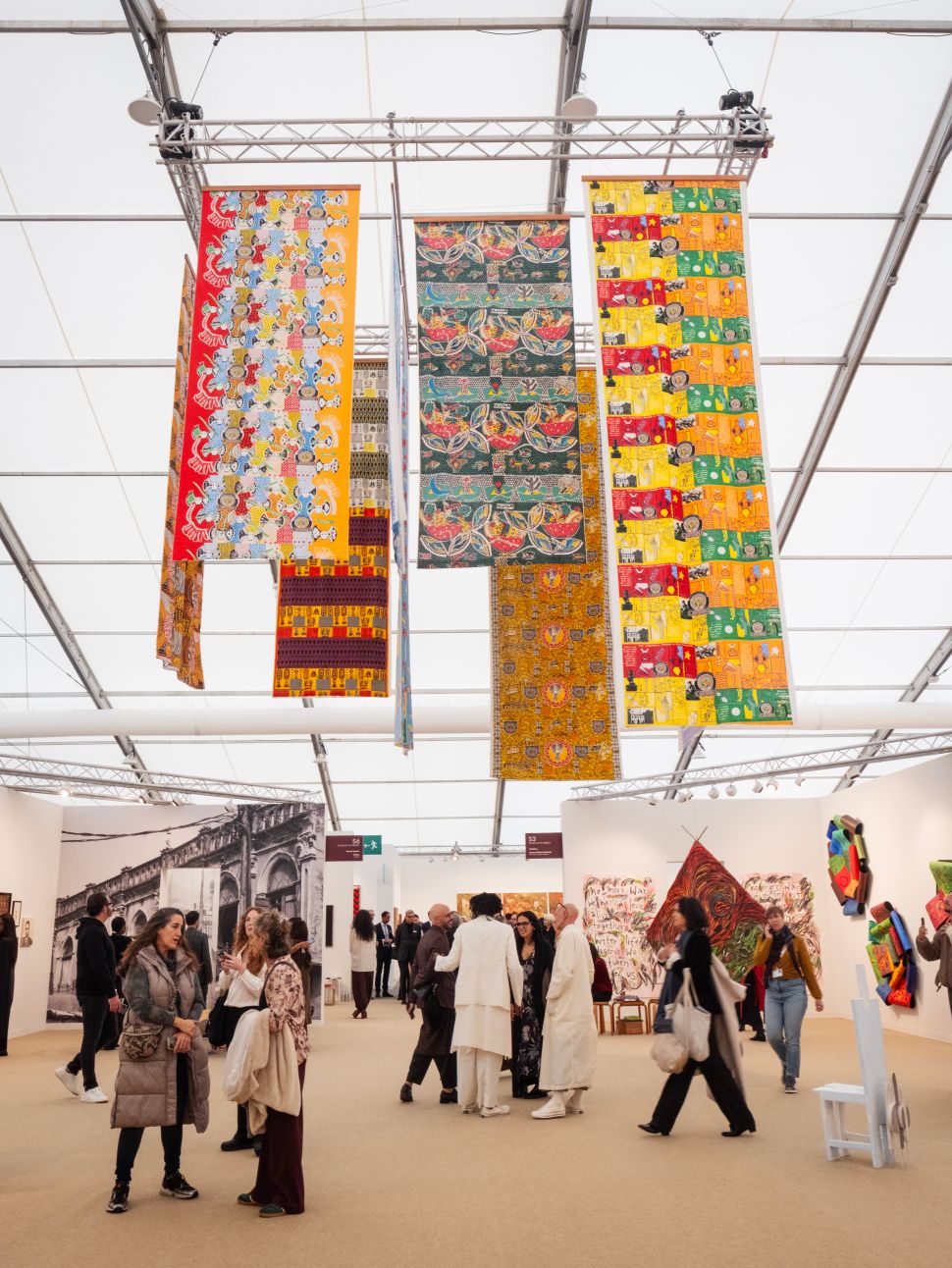 “Echoes in the Present” is a new section curated by Jareh Das that explores intergenerational dialogue between contemporary artists from Brazil, Africa and their diasporas. Photo: Linda Nylind | Courtesy of Frieze
“Echoes in the Present” is a new section curated by Jareh Das that explores intergenerational dialogue between contemporary artists from Brazil, Africa and their diasporas. Photo: Linda Nylind | Courtesy of Frieze
Among the most compelling contributions, São Paulo-based Simões de Assis presented rising artist Diambe, whose egg tempera and oil on linen paintings echo the organic patina of her fantastical bronze forms—creating surfaces that feel both ancient and intensely present, primordially grounded in nature yet visionarily attuned to a symbiotic future. Rooted in emotional intelligence and an alchemical transformation of materials, the works carry a votive charge, as if holding traces of ritual or offerings celebrating natural cycles. “Diambe’s work, deeply rooted in the material and spiritual experiences of the African diaspora, reflects the global resonance of Brazilian art today,” gallery director Guilherme Simões de Assis told Observer. “Presenting her in London situates Brazilian contemporary art within a transnational context that embraces ecology, ritual and the poetics of transformation.” The gallery reported strong interest in the modestly priced works as the artist prepares for her forthcoming exhibition at Kunsthalle Basel in January.
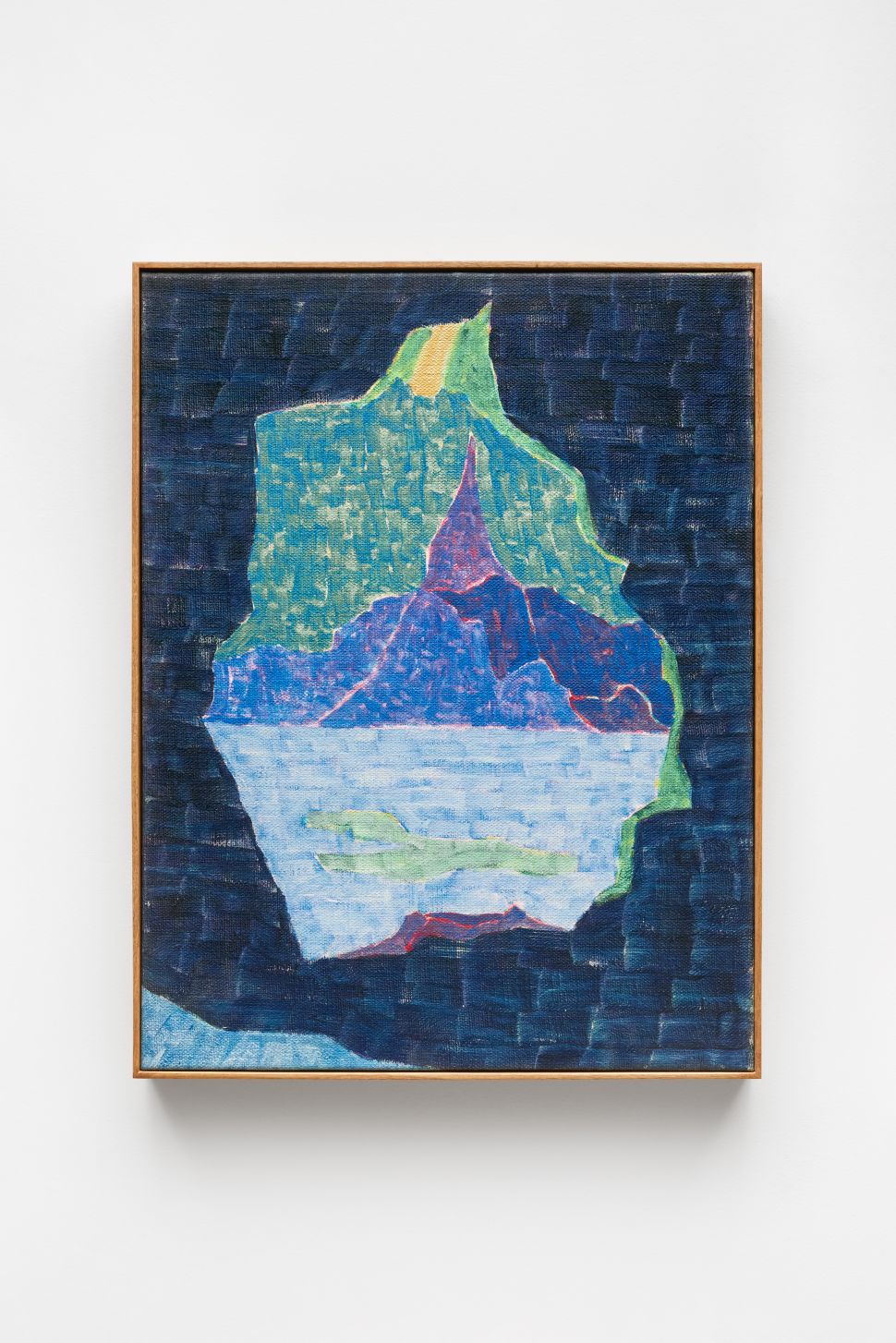 Simões de Assis presenting Diambe. BRUNO LEAO | Courtesy of the artist and Simões de Assis
Simões de Assis presenting Diambe. BRUNO LEAO | Courtesy of the artist and Simões de Assis
Nearby, Mitre Galeria presented Afro-Brazilian artist Aline Motta, whose stereoscopic 3D photographs layer family archives with the present—embodying ancestral presence while confronting the erasure of slavery’s history. In her hands, coffee plants become both memory and metaphor.
Fresh off her recently closed exhibition at MoMA PS1, Luanda-born artist Sandra Poulson presented another politically and memorially resonant installation with Jahmek Contemporary. Poulson’s practice draws on familial and social knowledge to dissect contemporary Angolan realities through semiotic studies of everyday objects—such as domestic utensils—that function as active agents in ongoing political and cultural transformation, inherently positioning her work within a decolonial framework.
Museum offerings and rediscoveries at Frieze Masters
This year, Frieze Masters genuinely rivaled Art Basel and TEFAF Maastricht in terms of encyclopedic ambition, with museum-quality presentations, historical rediscoveries, rare antiques and manuscripts, as well as five to seven blue-chip masters anchoring the fair.
Sold within the first hours for £650,000 was a triceratops head dated to the Late Cretaceous Period (circa 68 million years ago), presented by David Aroon right at the entrance. The gallery reported a dozen other sales of artifacts ranging from perfectly preserved Cycladic figurines to a complete skeleton of a saber-toothed Nimravidae dated to the Oligocene (circa 33.7-23.8 million years ago), which sold for a significant six-figure sum. “Frieze Masters always attracts collectors and curators from around the world. This year had an excellent opening day of the fair,” gallery director Salomon Aaron told Observer.
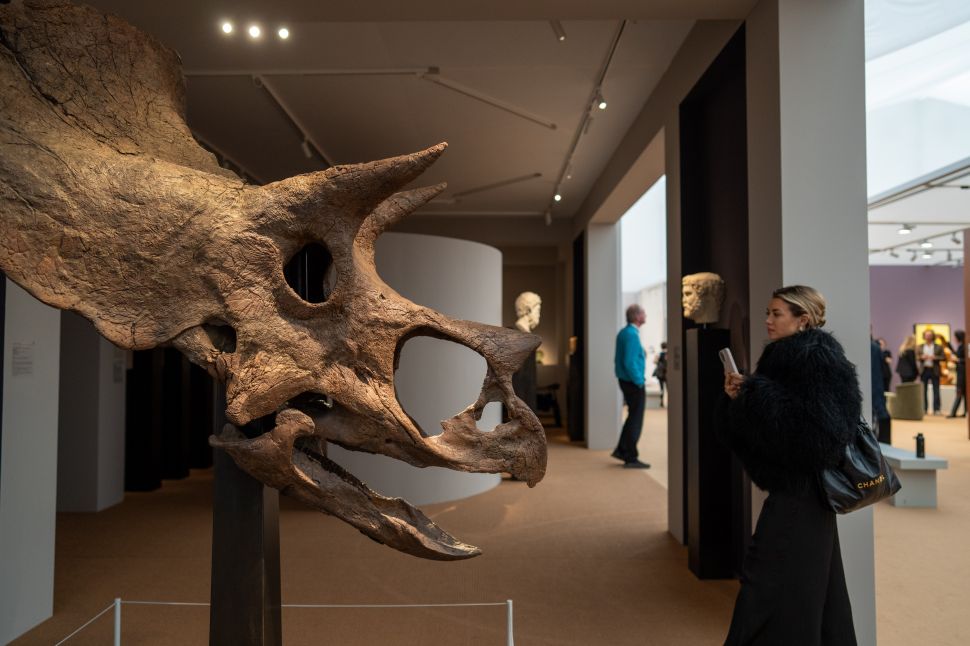 David Aaron at Frieze Masters 2025. Photo by Hugo Glendinning. Courtesy Frieze
David Aaron at Frieze Masters 2025. Photo by Hugo Glendinning. Courtesy Frieze
Meanwhile, on the modern and contemporary side, the New York gallery known for rediscovering and relaunching artist estates spotlighted American painter Janice Biala (1903-2000) in the Spotlight section of Frieze Masters 2025. The presentation featured seven important paintings from the 1950s and 1960s, exemplary of Biala’s signature melding of styles and cultures as she lived and worked between the U.S. and Paris. By evening, the gallery had placed four works, with prices ranging from $18,000 to $55,000.
One of the most memorable presentations came from San Francisco-based gallerist Wendi Norris, who debuted an exquisitely carved cradle in the form of a sailboat by Leonora Carrington—its surface covered in a densely symbolic painted narrative tracing the cycle of life as a fantastical hero’s journey inspired by fairytales, myth and the artist’s own boundless imagination. Originally made for her goddaughter, this is the second-largest sculpture Carrington ever produced, following the record-setting work sold at Christie’s last season and, as Norris subtly hinted, it carries a similarly six-figure price. “It’s a unique masterpiece—I do not think it is hyperbole to say there is nothing else in her oeuvre like it. Like a monumental painting in the round,” Norris commented. La cuna showcases Leonora’s singular gifts for storytelling, mythical synthesis and the delightfully unexpected. “We are thrilled to present it at Frieze Masters in England, where Leonora was born, as an enduring testament to her remarkable artistry and boundless creativity.”
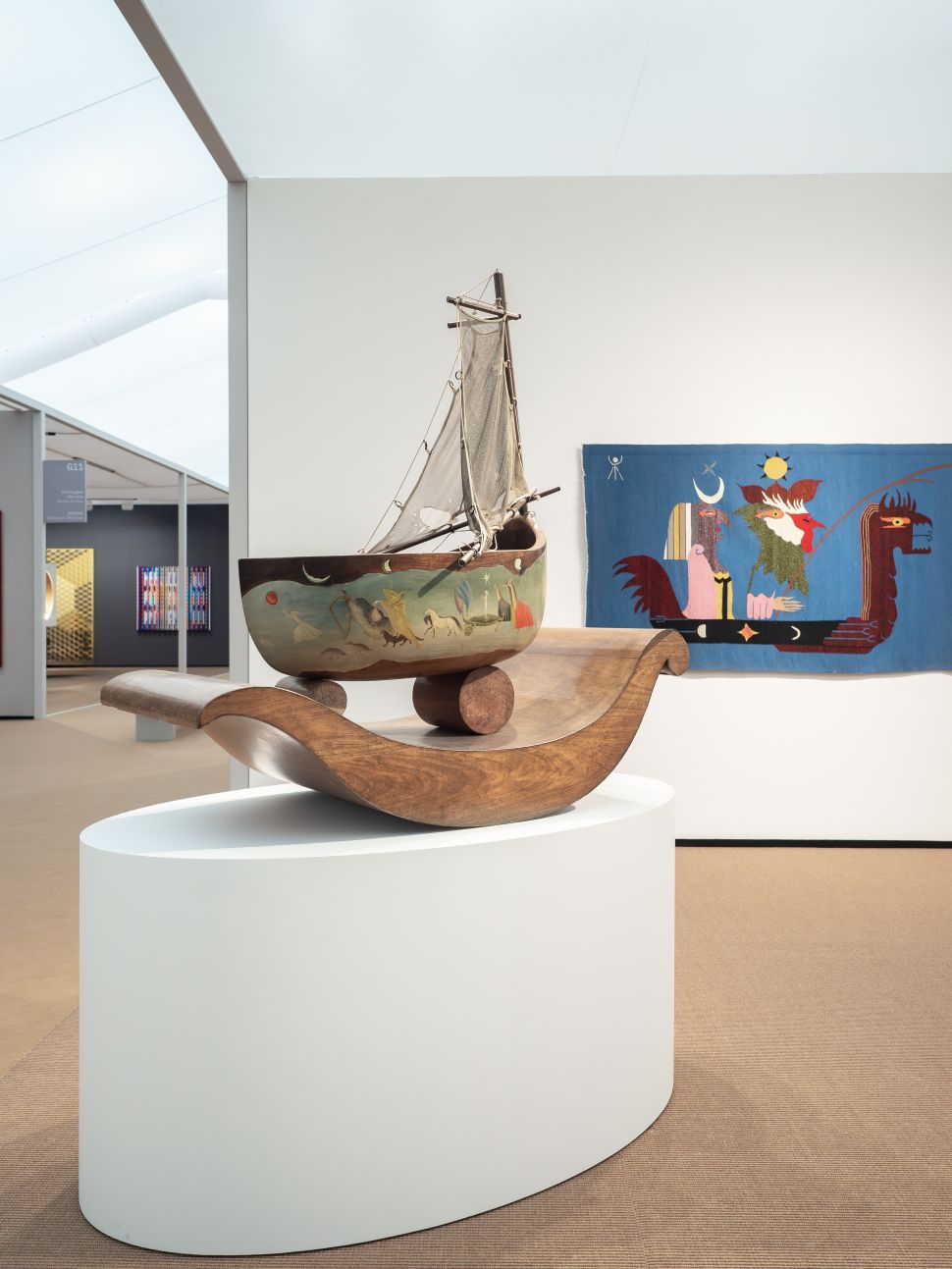 Wendy Norris at Frieze Masters 2025. Photo: MICHAEL ADAIR
Wendy Norris at Frieze Masters 2025. Photo: MICHAEL ADAIR
This special piece was paired with an untitled tapestry by Carrington that merges symbolic references to the Mesoamerican god Quetzalcoatl with fabrication by a family of master weavers from San Miguel Chiconcuac, shown alongside works by Wolfgang Paalen, Alice Rahon, Remedios Varo and Peter Young—artists whose practices were profoundly shaped by their time in Mexico. Notably, Norris, one of the first gallerists to champion Surrealist and visionary women artists, has long been Carrington’s dealer, working with her during her lifetime and well before the institutional and market surge that followed her celebrated Venice Biennale inclusion. Since 2004, the gallery has also been the principal steward of Remedios Varo’s equally imaginative universe, mounting multiple solo exhibitions that helped reignite attention to her fantastical work.
Among the artists worth discovering at Frieze Masters was Mozambican artist Teresa Roza d’Oliveira, presented by Portugal’s Perve Galeria—a pioneering African feminist and activist whose work has long been overlooked. Born on the Island of Mozambique to Portuguese parents, d’Oliveira developed a fiercely expressive visual language: archetypically symbolic, emotionally raw and unafraid to confront the “demons” of society—patriarchy, oppression and internal conflict. Living at the constant crossroads of African and European identity, she resisted all attempts at easy categorization and spent her life struggling to “fit”—a white woman born in Africa during independence, and one of the few artists of her generation to openly embrace a same-sex relationship in the 1970s. The resulting paintings and drawings from the 1960s to the late 1970s—many shown publicly for the first time—merge poetic reflections on female experience with intuitive symbolism and radical political charge, forming a body of work that feels historically pivotal and urgently contemporary.
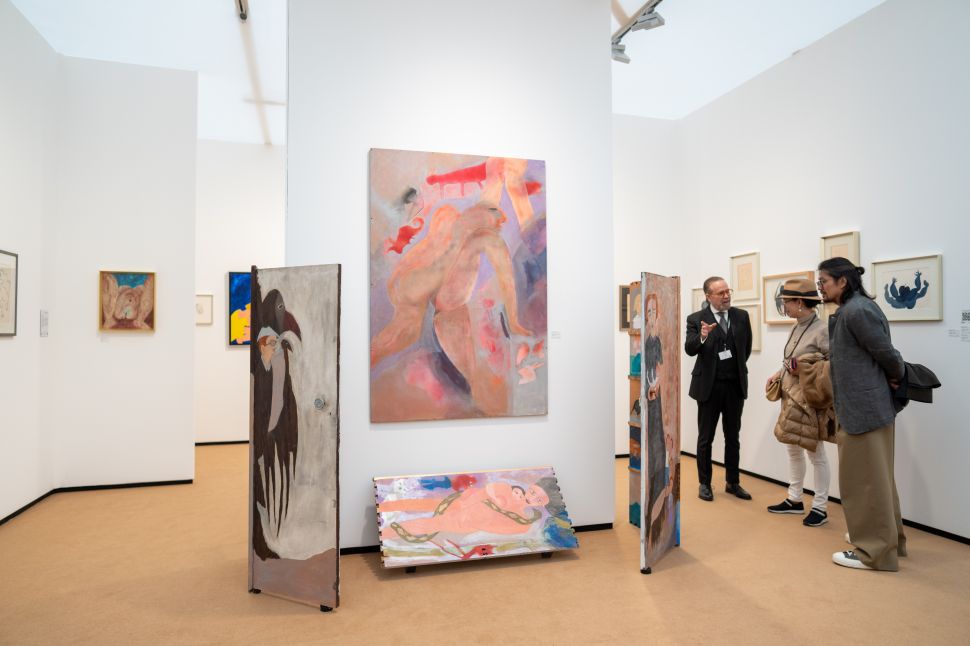 Perve Galleria at Frieze Masters 2025. Photo: Hugo Glendinning
Perve Galleria at Frieze Masters 2025. Photo: Hugo Glendinning
Among the blue-chip names, Gagosian presented a solo booth of virtuosic new paintings by Glenn Brown inspired by art history, while Ben Brown paired works by Lucio Fontana and Alighiero Boetti with creations by the highly in-demand design duo Claude Lalanne and François-Xavier Lalanne, selling various pieces with prices ranging from $300,000 to $800,000.
Growing international interest in Aboriginal art was unmistakable, especially as Emily Kame Kngwarreye prepares for her major retrospective at Tate Modern this fall—a milestone confirmed by D’Lan Contemporary, which saw immediate market response in London. The gallery reported strong first-day sales for leading Western Desert artists of the generation that followed Kngwarreye and were notably shaped by her legacy. Several works by Makinti Napanangka sold steadily at AUD 60,000, 120,000 and 150,000, culminating in a record-breaking AUD 280,000 ($182,000) sale for a 2008 Lupulnga painting to a private New York collector. The gallery also placed two works by Naata Nungurrayi for AUD 140,000 ($91,000) and AUD 280,000 ($182,000), both acquired by a New York private collection—underscoring the surging global demand for historically significant Aboriginal women artists.
The list of noteworthy sales and presentations at both fairs could go on, reaffirming that the historic London edition remains a prime international platform—strategically vital to both the market and the broader art world. Far from being overshadowed, Frieze London not only coexists with the newly empowered Art Basel Paris but proves it can still compete at the highest level—and hold its ground.
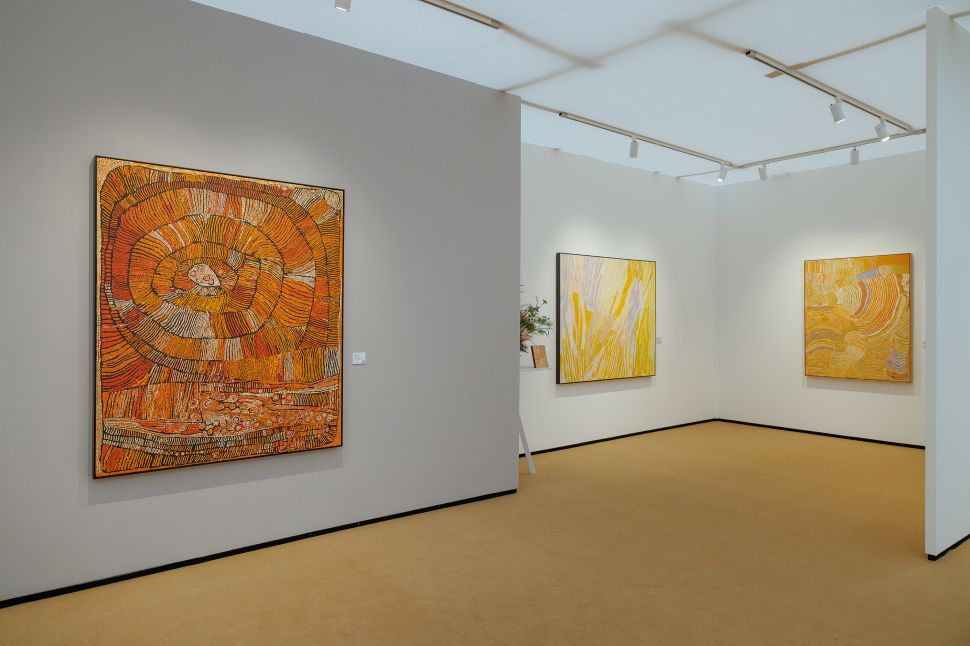 D’Lan Contemporary at Frieze Masters 2025. Photo: Dan Weill
D’Lan Contemporary at Frieze Masters 2025. Photo: Dan Weill
More in art fairs, biennials and triennials
